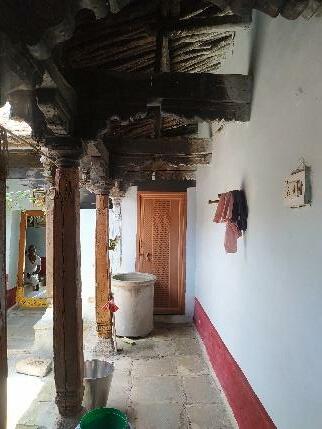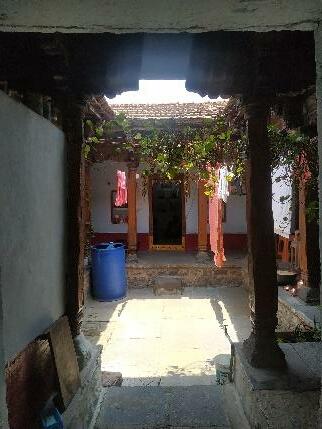
2 minute read
FIGURE 63 ENTRANCE
from DISSERTATION
by Bhuvana
3.3 LIVE CASE STUDY – 3 HOUSE AT CHEEKURTHI
SITE AREA: 162 sq.m. LOCATION: Cheekurthi, North Karnataka
Advertisement
The residential building selected for the study is located at Cheekurthi village, the border area of Telangana & North Karnataka. It is a courtyard house surrounded by rooms around the courtyard. The building’s area is approximately 162 sq.m. The home has a rectangle layout that runs north to south, with the main entrance facing north.
The dwellings are strategically placed to reduce heat intake and loss. Light and air from the courtyard are dispersed and distributed throughout the building via the internal verandah, which serves as the main axis of circulation. To stop moisture from the ground from entering, high plinths are offered. The 300mm-thick walls reduce heat transfer into the house, which is not necessary for structural strength otherwise. The time lag between heat conduction is also lengthened by the roughly 3000 mm high ceiling and the 300 mm thick roof. All-local materials are utilised to create the structure, including wood for the rafters and internal roof as well as the columns, black stone and mud for the walls' plaster, thandur stone and rubble stone for the floor, Mangalore tiles and metal roofing sheets for the outside roof.


Figure 61 INTERNAL VERANDAH Figure 62 COURTYARD Figure 63 ENTRANCE
[SOURCE – AUTHOR] [SOURCE – AUTHOR] [SOURCE – AUTHOR]
Climatic Factors that are influencing in the architecture of building are - Because the environment in Cheekurthi, North Karnataka, is hot and humid, the structure has strong walls constructed of black stone and mud is utilised as plaster, which works as a heat resistant substance. There is also greenery around the structure where there would be little temperature drop. Also, the humidity in this area is high. The courtyard is effective in stack effect, and the building's huge openings ensure a flow of cool air. The structure has considerable space for unobstructed air flow and ventilation. Semi-open areas can also help to reduce excessive heat and humidity. The precipitation is very considerable in this location, thus the home has a pitched roof for rain and the floor surrounding the courtyard is elevated to prevent wetness. During heavy rain, water drains through the courtyard. The structure features strong insulating and reflecting roofing material to limit the impact of direct solar radiation, and white paint reflects the heat away. The building's surface area is less exposed to the sun. Because the structure is long and thin, air moves freely. The cold air is drawn into the structure by the vegetation that surrounds it.










